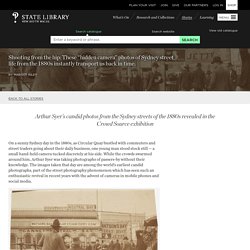

Colonies after the 1800s. Population distribution / settlement patterns. Impact on Aboriginal peoples. Everyday life for people in the colonies. The Rabbits Part 1. The Rabbits Part 2. Frontier conflict. Gold rush. People - Gold miners and mining. Characters of the Goldfields. Eureka Stockade. Characters of the Goldfields. Eureka Stockade women who made the flag. The most potent symbol of Australia's only rebellion, the Eureka Stockade, is the blue and white Southern Cross flag.

A replica of the full flag will soon be on display in Ballarat. Verica Jokic asks what we know about the women who supposedly stitched the flag in one day under the cover of darkness. A replica of the Eureka Flag will soon be unfurled to flap in the Ballarat wind. The flag has been stitched as part of the 160th anniversary commemorations of the Eureka Stockade. On 29 November, 1854, gold miners saw the enormous flag for the first time at Bakery Hill.
Fifteen thousand people, half the population of Ballarat, turned up. Four days later, the flag was moved to the centre of a hastily built stockade at the Eureka diggings, where miners had gathered for a confrontation with government troops and police. Within 20 minutes the battle was over, 27 men were dead, and the flag was torn down and attacked. It measured four metres by 2.6 metres and was made of bolts of woollen fabric.
Internal exploration. Pearling. Transport. Wine industry. Wool industry. Migration. Significant people. Frontier warriors. Pemulwuy Pemulwuy was one of the earliest recorded resistance fighters of the Frontier Wars.

A Bidgigal man of the Darug nation he reportedly had a clubbed foot, suggesting he may have been a Carradhy (clever man). In Port Jackson in 1790 he speared John McIntyre, the gamekeeper of Governor Phillip, who later died of his injuries. The Governor then called for an expedition in retaliation however it failed to find any Aboriginal people. From 1792, Pemulwuy lead continued attacks on farming settlements: burning huts and stealing crops. Despite recognising Pemulwuy as "a brave and independent character", Governor King offered a reward for his death or capture and issued a government order than any Aboriginal people seen near Parramatta should be shot on site. Engraving of 'Pimbloy' believed to be of Pemulwuy by Samuel John Neele Source: State Library of Victoria Musquito Windradyne Windradyne, a Wiradjuri warrior, was a key resistance figure in the Bathurst War in 1824.
Yagan Jandamarra. State Library of NSW. On a sunny Sydney day in the 1880s, as Circular Quay bustled with commuters and street traders going about their daily business, one young man stood stock still — a small hand-held camera tucked discretely at his side.

While the crowds swarmed around him, Arthur Syer was taking photographs of passers-by without their knowledge. The images taken that day are among the world’s earliest candid photographs, part of the street photography phenomenon which has seen such an enthusiastic revival in recent years with the advent of cameras in mobile phones and social media. Invented in about 1880, the hand-held camera — initially marketed as a ‘Detective Camera’ — was the latest in photographic gadgetry. Along with dry plate negative technology, it was the most significant development in photography in decades. Photographers could now venture out of their studios unencumbered by heavy equipment.